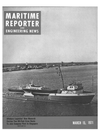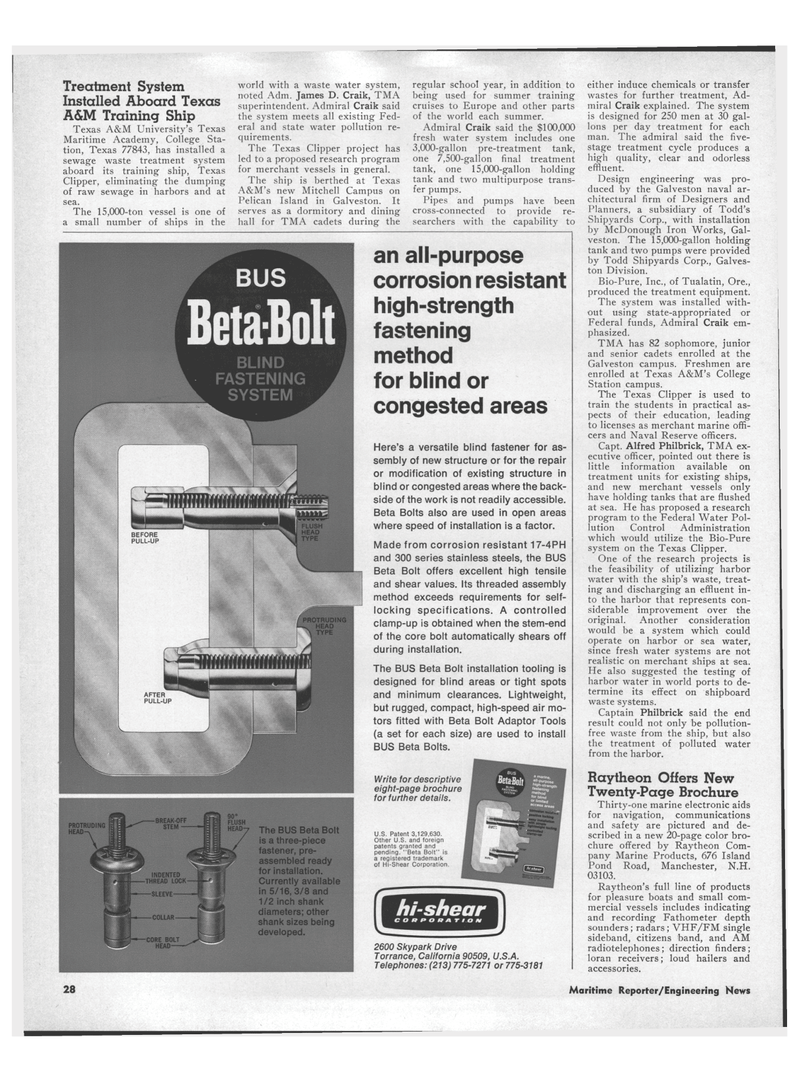
Page 26: of Maritime Reporter Magazine (March 15, 1971)
Read this page in Pdf, Flash or Html5 edition of March 15, 1971 Maritime Reporter Magazine
Treatment System
Installed Aboard Texas
A&M Training Ship
Texas A&M University's Texas
Maritime Academy, College Sta- tion, Texas 77843, has installed a sewage waste treatment system aboard its training ship, Texas
Clipper, eliminating the dumping of raw sewage in harbors and at sea.
The 15,000-ton vessel is one of a small number of ships in the world with a waste water system, noted Adm. James D. Craik, TMA superintendent. Admiral Craik said the system meets all existing Fed- eral and state water pollution re- quirements.
The Texas Clipper project has led to a proposed research program for merchant vessels in general.
The ship is berthed at Texas
A&M's new Mitchell Campus on
Pelican Island in Galveston. It serves as a dormitory and dining hall for TMA cadets during the regular school year, in addition to being used for summer training cruises to Europe and other parts of the world each summer.
Admiral Craik said the $100,000 fresh water system includes one 3,000-gallon pre-treatment tank, one 7,500-gallon final treatment tank, one 15,000-gallon holding tank and two multipurpose trans- fer pumps.
Pipes and pumps have been cross-connected to provide re- searchers with the capability to either induce chemicals or transfer wastes for further treatment, Ad- miral Craik explained. The system is designed for 250 men at 30 gal- lons per day treatment for each man. The admiral said the five- stage treatment cycle produces a high quality, clear and odorless effluent.
Design engineering was pro- duced by the Galveston naval ar- chitectural firm of Designers and
Planners, a subsidiary of Todd's
Shipyards Corp., with installation by McDonough Iron Works, Gal- veston. The 15,000-gallon holding tank and two pumps were provided by Todd Shipyards Corp., Galves- ton Division.
Bio-Pure, Inc., of Tualatin, Ore., produced the treatment equipment.
The system was installed with- out using state-appropriated or
Federal funds, Admiral Craik em- phasized.
TMA has 82 sophomore, junior and senior cadets enrolled at the
Galveston campus. Freshmen are enrolled at Texas A&M's College
Station campus.
The Texas Clipper is used to train the students in practical as- pects of their education, leading to licenses as merchant marine offi- cers and Naval Reserve officers.
Capt. Alfred Philbrick, TMA ex- ecutive officer, pointed out there is little information available on treatment units for existing ships, and new merchant vessels only have holding tanks that are flushed at sea. He has proposed a research program to the Federal Water Pol- lution Control Administration which would utilize the Bio-Pure system on the Texas Clipper.
One of the research projects is the feasibility of utilizing harbor water with the ship's waste, treat- ing and discharging an effluent in- to the harbor that represents con- siderable improvement over the original. Another consideration would be a system which could operate on harbor or sea water, since fresh water systems are not realistic on merchant ships at sea.
He also suggested the testing of harbor water in world ports to de- termine its effect on shipboard waste systems.
Captain Philbrick said the end result could not only be pollution- free waste from the ship, but also the treatment of polluted water from the harbor.
Raytheon Offers New
Twenty-Page Brochure
Thirty-one marine electronic aids for navigation, communications and safety are pictured and de- scribed in a new 20-page color bro- chure offered by Raytheon Com- pany Marine Products, 676 Island
Pond Road, Manchester, N.H. 03103.
Raytheon's full line of products for pleasure boats and small com- mercial vessels includes indicating and recording Fathometer depth sounders; radars; VHF/FM single sideband, citizens band, and AM radiotelephones ; direction finders; loran receivers; loud hailers and accessories.
BUS
Beta-Bolt
BLIND
FASTENING
SYSTEM
The BUS Beta Bolt is a three-piece fastener, pre- assembled ready for installation.
Currently available in 5/16, 3/8 and 1/2 inch shank diameters; other shank sizes being developed. an all-purpose corrosion resistant high-strength fastening method for blind or congested areas
Here's a versatile blind fastener for as- sembly of new structure or for the repair or modification of existing structure in blind or congested areas where the back- side of the work is not readily accessible.
Beta Bolts also are used in open areas where speed of installation is a factor.
Made from corrosion resistant 17-4PH and 300 series stainless steels, the BUS
Beta Bolt offers excellent high tensile and shear values. Its threaded assembly method exceeds requirements for self- locking specifications. A controlled clamp-up is obtained when the stem-end of the core bolt automatically shears off during installation.
The BUS Beta Bolt installation tooling is designed for blind areas or tight spots and minimum clearances. Lightweight, but rugged, compact, high-speed air mo- tors fitted with Beta Bolt Adaptor Tools (a set for each size) are used to install
BUS Beta Bolts.
Write for descriptive eight-page brochure for further details.
U.S. Patent 3,129,630.
Other U.S. and foreign patents granted and pending. "Beta Bolt" is a registered trademark of Hi-Shear Corporation. hi-shear 2600 Skypark Drive
Torrance, California 90509, U.S.A.
Telephones: (213) 775-7271 or 775-3181 28 Maritime Reporter/Engineering News

 25
25

 27
27
